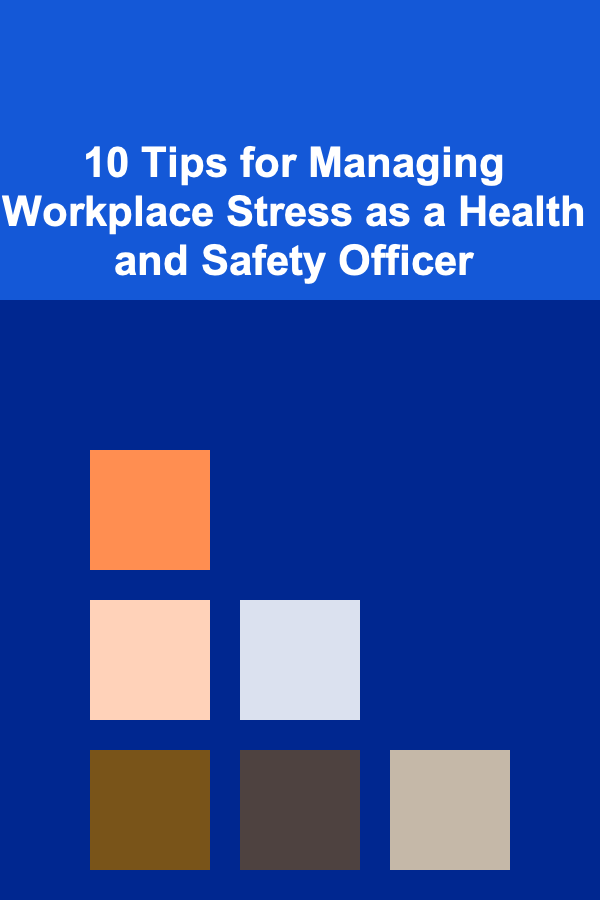
10 Tips for Managing Workplace Stress as a Health and Safety Officer
ebook include PDF & Audio bundle (Micro Guide)
$12.99$10.99
Limited Time Offer! Order within the next:

As a Health and Safety Officer, your primary role is to ensure a safe working environment for all employees. This responsibility can be both demanding and highly stressful. You're expected to handle emergency situations, implement safety protocols, ensure compliance with laws and regulations, and constantly monitor and assess the risks that could impact the health and safety of the workforce. While these tasks are crucial for organizational success, they can also lead to high levels of stress.
Workplace stress, if not managed effectively, can lead to burnout, decreased productivity, and even physical and mental health issues. Therefore, it is essential for Health and Safety Officers to have effective stress management strategies in place. In this article, we will explore 10 essential tips that can help Health and Safety Officers manage stress and maintain their well-being while performing their critical duties.
Prioritize Self-Care and Wellness
Before you can take care of others, you must take care of yourself. Self-care is essential for maintaining physical and mental health, especially in a high-pressure role like a Health and Safety Officer.
Practical Self-Care Strategies:
- Exercise regularly: Physical activity is proven to reduce stress levels, improve mood, and boost energy. Aim for at least 30 minutes of moderate exercise a few times a week.
- Eat a balanced diet: Proper nutrition can help maintain energy levels and mental clarity. Avoid relying on caffeine and processed foods that can increase anxiety.
- Get enough sleep: Lack of sleep can increase stress and impair decision-making abilities. Aim for 7-9 hours of sleep per night to stay sharp and alert.
- Relaxation techniques: Incorporate mindfulness practices such as meditation, deep breathing exercises, or yoga into your daily routine to reduce stress and improve focus.
Set Clear Boundaries and Expectations
As a Health and Safety Officer, you might be juggling multiple tasks, often under time constraints. Setting clear boundaries can prevent feelings of being overwhelmed and help you stay focused on your primary responsibilities.
How to Set Boundaries:
- Establish working hours: Avoid taking work calls or responding to emails outside of your designated working hours.
- Learn to say no: It's important to recognize when you have too much on your plate. Politely decline additional tasks that could compromise your ability to perform your core duties effectively.
- Delegate when appropriate: Trust your team members to handle tasks that don't require your direct involvement. Delegating can help reduce your workload and prevent burnout.
Stay Organized with Task Management
With the complex nature of health and safety responsibilities, organization is crucial to reduce stress and prevent mistakes. A well-organized approach will help you stay on top of your duties and create a more predictable and manageable workload.
Tips for Better Organization:
- Use a task management tool: Utilize tools like Asana, Trello, or Microsoft To-Do to track tasks, deadlines, and priorities.
- Create checklists: Develop daily, weekly, and monthly checklists to ensure that you're meeting all of your safety obligations.
- Set realistic deadlines: Break down larger projects into smaller tasks with achievable deadlines to avoid feeling overwhelmed by looming timelines.
Practice Effective Communication
Effective communication can prevent misunderstandings, improve collaboration, and reduce stress. As a Health and Safety Officer, clear communication with management, employees, and contractors is key to ensuring safety protocols are followed.
How to Communicate Effectively:
- Be concise and direct: Avoid jargon and provide clear instructions on safety procedures. This reduces confusion and ensures that everyone is on the same page.
- Listen actively: Pay attention to concerns from employees, supervisors, and others. Active listening allows you to address issues proactively before they escalate.
- Provide regular updates: Keep stakeholders informed about safety initiatives, training sessions, inspections, and compliance. Transparency helps reduce uncertainty and builds trust.
Focus on Time Management
Managing your time effectively is essential when balancing multiple tasks and responsibilities. Good time management can help you stay calm and reduce stress by making sure that important tasks are prioritized.
Time Management Strategies:
- Use the Pomodoro Technique: This time management method involves working in short bursts (usually 25 minutes), followed by a short break. This helps maintain focus and productivity throughout the day.
- Prioritize tasks: Determine which tasks are the most urgent and important, and tackle those first. Use the Eisenhower Matrix to differentiate between what is urgent and what is important.
- Avoid multitasking: Focus on one task at a time to ensure that each task is completed efficiently and correctly.
Seek Support from Peers and Supervisors
As a Health and Safety Officer, you are often working under intense pressure, but you don't have to do it alone. Building a support network within your organization can provide the resources and encouragement you need to manage stress effectively.
Ways to Seek Support:
- Join professional groups or forums: Engage with other health and safety professionals to share experiences, discuss challenges, and seek advice.
- Talk to your supervisor: If you feel overwhelmed, communicate with your supervisor about your workload and discuss strategies to manage tasks more effectively.
- Mentorship: Find a mentor within your organization or industry who can provide guidance and support when you're facing difficult situations.
Regularly Review and Update Safety Protocols
A significant part of your role is ensuring that safety protocols are up-to-date and relevant. Taking a proactive approach to review and improve safety procedures can prevent unnecessary stress caused by accidents or compliance issues.
Steps to Update Safety Protocols:
- Conduct regular audits: Periodically review workplace safety practices, equipment, and training to ensure they meet current regulations and industry standards.
- Engage employees in safety discussions: Encourage employees to share feedback on safety procedures. This can help identify areas for improvement and foster a safety-first culture.
- Stay informed about regulations: Regularly read up on local, state, and federal safety regulations to ensure that your protocols remain compliant.
Learn to Manage Emergency Situations Calmly
Emergency situations are inevitable, and as a Health and Safety Officer, you will need to respond swiftly and effectively. Learning to stay calm in the face of an emergency is a key skill that can reduce stress and prevent panicked decision-making.
How to Manage Emergency Situations:
- Stay calm and focused: Practice deep breathing exercises and visualization techniques to maintain composure during emergencies.
- Develop clear emergency response plans: Ensure that there is a well-structured plan in place for various scenarios. Train employees regularly on these procedures so they know how to act during emergencies.
- Delegate tasks: In high-pressure situations, delegate tasks to trusted team members to manage the response more effectively and reduce the workload on yourself.
Take Regular Breaks
Working as a Health and Safety Officer can be physically and mentally taxing. Taking regular breaks is essential to avoid burnout and maintain focus throughout the day.
Why Breaks are Important:
- Mental refreshment: Taking short breaks allows you to reset your mind and regain focus, reducing mental fatigue.
- Physical well-being: Moving away from your desk or workstation helps reduce the physical strain that can accumulate from long periods of sitting or standing.
- Improved productivity: Breaks improve overall productivity by preventing burnout and maintaining high levels of concentration.
Practice Resilience and Adaptability
The nature of the role means that things rarely go exactly as planned. The ability to bounce back from setbacks and adapt to changing circumstances is crucial for long-term success.
How to Build Resilience:
- Maintain a positive mindset: Reframe challenges as opportunities for growth rather than setbacks.
- Learn from mistakes: Use mistakes as learning experiences to improve your future performance and stress management strategies.
- Stay flexible: Be ready to adapt when situations change unexpectedly, and embrace new strategies or tools that can make your job easier.
Conclusion
Managing workplace stress as a Health and Safety Officer requires a combination of personal resilience, organizational strategies, and proactive communication. By incorporating these 10 tips into your daily routine, you can reduce stress levels, enhance your performance, and ensure that you remain a healthy, effective leader in promoting workplace safety. Remember that it's not just about managing stress---it's about thriving in your role while maintaining a balanced, healthy lifestyle.
Reading More From Our Other Websites
- [Personal Care Tips 101] How to Choose a Shampoo for Dry and Damaged Hair
- [Home Family Activity 101] How to Plan a DIY Family Camping Trip in Your Own Backyard
- [Screen Printing Tip 101] Preventing Bleed-Through: Best Practices for Dark-Shirt Screen Prints
- [Reading Habit Tip 101] From Skimming to Deep Dive: Choosing the Right Reading Technique for Any Material
- [Home Space Saving 101] How to Choose Space-Saving Furniture for Efficient Living
- [Personal Finance Management 101] How to Create a Sustainable Spending Plan for Long-Term Wealth
- [Home Storage Solution 101] How to Achieve Home Storage and Organization with DIY Solutions
- [Home Lighting 101] How to Select and Position Ceiling Lights to Brighten Any Room Effectively
- [Personal Financial Planning 101] How to Create a Debt Repayment Plan and Stay on Track
- [Mindful Eating Tip 101] Fast-Track Nutrition: Mindful Eating Hacks for the Hectic Professional

Best Organization Tools for Memory and Note-taking
Read More
How to Involve Local Businesses in Supporting Your Reunion
Read More
How to Maximize Your Savings Through High-Interest Accounts
Read More
How to Organize a Family Reunion for Seniors
Read More
How to Practice Forgiveness for Mental Freedom
Read More
Identifying and Avoiding Vishing and Smishing Scams
Read MoreOther Products

Best Organization Tools for Memory and Note-taking
Read More
How to Involve Local Businesses in Supporting Your Reunion
Read More
How to Maximize Your Savings Through High-Interest Accounts
Read More
How to Organize a Family Reunion for Seniors
Read More
How to Practice Forgiveness for Mental Freedom
Read More